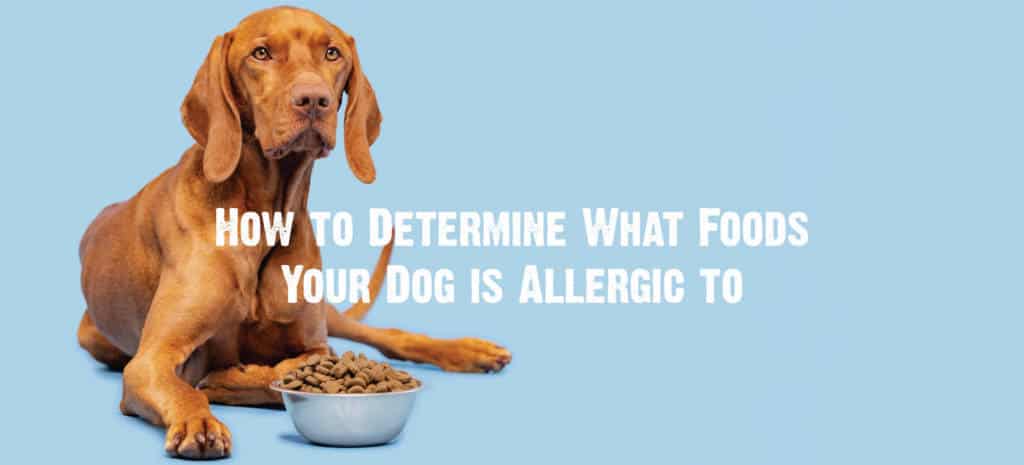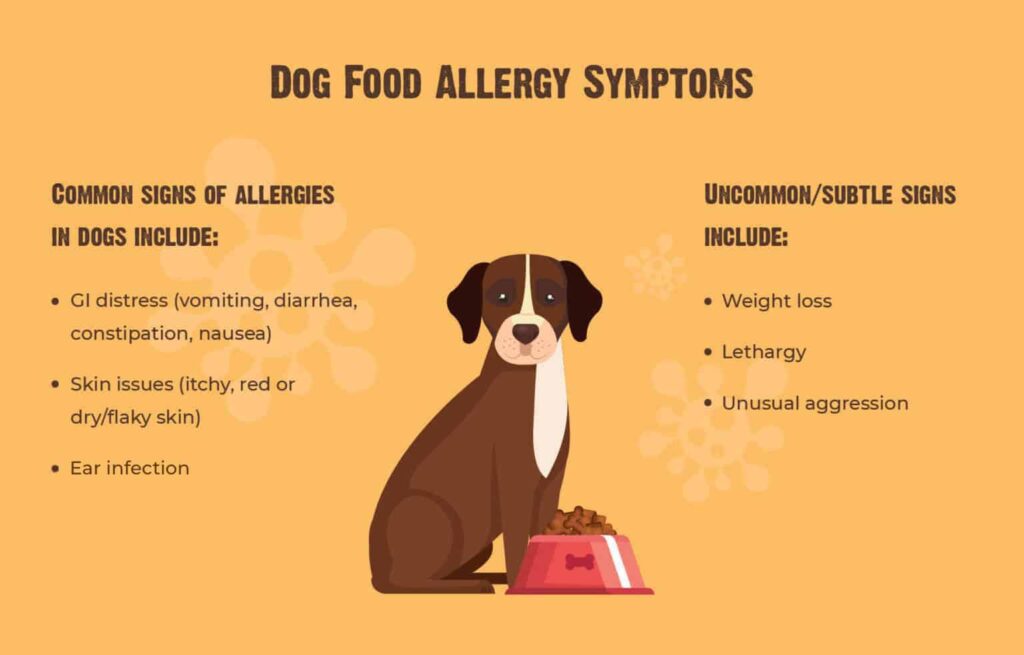We all want the best for our four-legged family members. An important part of keeping them healthy is providing them with a nutritious diet and avoiding any foods that may cause harm, including in the form of food allergies. This post covers common dog food allergies, symptoms and ways to identify these allergens.
Can Dogs Have Allergies?

Yes, like humans, dogs can have allergies, which can manifest with a range of symptoms. During an allergic reaction, a dog’s immune system produces excess antibodies in reaction to a certain food. This results in an allergic reaction, such as itchy skin, rash, vomiting or diarrhea. Although any food can trigger an immune system response, the most common allergens come from proteins or complex carbohydrates.
Food Intolerances or Sensitivities
Intolerances or sensitives may present with similar symptoms to allergies, but there is a major difference between them. With an intolerance or sensitivity, a dog has trouble properly digesting an ingredient. With an allergy, the ingredient triggers an immune response and the dog’s immune system produces antibodies. This is important to understand when introducing your dog to new foods, because gradual introduction and slow transitions may help reduce the risk of intolerances.
THE BEST DOG FOOD FOR SENSITIVE STOMACHS [WITH FAQS] >
Food Allergies Vs. Food Intolerance
Food intolerances or sensitivities may present with similar symptoms to allergies, but there is a major difference between them.
With an allergy, a food or ingredient triggers an immune response, causing the dog’s immune system to overreact and produce antibodies against it. Interestingly, an allergy can develop over a prolonged period of eating the same food, which is why some of the most common dog food allergies are caused by exceedingly normal dog food ingredients. This is why dogs can sometimes become allergic to their “usual” food.
On the other hand, with an intolerance or sensitivity, a dog has trouble properly digesting an ingredient, but this reaction does not come from the immune system. A food intolerance may present itself through gastrointestinal distress, including symptoms like excessive gas, diarrhea, vomiting or a lack of interest in food.
Unlike an allergy, an intolerance does not mean that a dog can never eat that ingredient again. This is important to keep in mind when introducing your dog to new foods, because slow transitions may help reduce the risk of intolerances.
When switching between dog foods, start slowly by mixing small amounts of the new food into your dog’s existing food, then gradually increase the ratio of new food and keep an eye out for adverse reactions. Remember that your dog’s body may just need a little extra time to acclimate to a new food.
THE BEST DOG FOOD FOR SENSITIVE STOMACHS [WITH FAQS] >
Dog Food Allergy Symptoms
Common signs of allergies in dogs include:
- GI distress: This is a general category of symptoms that originate in the stomach or intestines, including vomiting, diarrhea, constipation or nausea. You will most likely be able to tell when your dog is experiencing GI distress: the symptoms will either be apparent, or changes in your dog’s behavior may indicate discomfort.
- Skin issues: Food allergies in dogs can cause itchy, red or dry/flaky skin. Watch your dog to see if they are itching themselves repeatedly with their back claws (causing painful “hot spots”), chewing their paws or scooting their rear end along the floor. Symptoms like these can be caused by other health issues, so consult your dog’s vet to rule out other sources of skin irritation.
- Ear infection: This is often considered a secondary symptom of food allergies, since a dog’s ear canal can become infected through repeated scratching of dry skin with germ-covered claws. Food-induced inflammation can also cause an ear infection.
If you notice any of the following symptoms, food allergies are likely not the culprit, and should receive immediate attention. Uncommon/subtle signs of food allergies in dogs include:
- Lethargy: Loss of energy can be hard to detect right away, especially if you have an older adult dog. If you do notice your dog losing interest in walks or playtime, it could be a symptom of GI discomfort caused by an allergic reaction.
- Weight loss: There are a number of serious health issues that cause dogs to lose weight — like poor nutrient absorption or parasites — but food allergies are usually not one of them. Use this Body Condition Scoring chart to gauge any significant weight loss.
- Unusual aggression: This reaction is rare, but if your dog is snapping, growling or barking more than usual, it may be due to a change in their diet.
Anaphylactic shock is a rare reaction to a food-based allergen, but it does happen. If you observe your dog having trouble breathing or walking, drooling excessively or displaying other signs of shock after a meal, seek veterinary attention immediately.
11 Of The Most Common Dog Food Allergies
Protein and complex carbohydrates are the most common canine allergens. In an oft-cited study, beef, dairy products, chicken and wheat were found to cause the most food-related allergies in dogs. These top four allergens are followed by eggs, lamb, soy, corn, pork, fish and rice.
- Beef (34%) – Beef is a very common ingredient in dog food, but with so much exposure to this protein source, many dogs develop an allergic reaction to it over time.
- Dairy Products (17%) – Like humans, dogs can develop adverse reactions to dairy over their lifetimes. A dairy allergy can manifest as itchy, irritated skin or digestive issues such as gas, diarrhea or vomiting. An intolerance to dairy can also cause GI distress, so introduce your dog to it slowly if adding dairy to their diet.
- Chicken (15%) – As with beef, the prevalence of chicken protein in dog food has resulted in it becoming a common allergen.
- Wheat (13%) – A complex carbohydrate, wheat commonly triggers an immunological response in dogs that causes dry skin, rashes and inflammation.
- Soy (6%) – Soy is a “sneaky” ingredient in many commercial dog foods, where it appears in the form of soybean meal, germ meal, soy flour, soy grits or soy protein concentrate.
- Lamb (5%) – Many dog owners switch to lamb after their dog develops a beef or chicken allergy, but lamb itself can become an allergen if fed too frequently.
- Corn (4%) – Corn and corn by-products contain very little nutritional value for dogs, but it is an extremely common ingredient in commercial dog foods. Consider switching to a raw or almost-raw diet to avoid an allergic reaction in your dog.
- Eggs (4%) – Eggs can be an excellent source of non-meat protein, especially in raw diets, but they can also cause food allergy symptoms in dogs.
- Pork (2%) – Alongside beef and chicken, pork is a common dog food ingredient, but the incidence of allergic reactions in dogs is much lower.
- Fish (2%) – Freshwater fish like salmon are high in beneficial omega-3 fatty acids and a good alternative to mammal proteins. However, a dog’s early prolonged exposure to fish can lead to an allergy. As a general rule, use caution when feeding your dog shellfish, and use caution with saltwater fish due to the possibility of parasites or high mercury content.
- Rice (2%) – Like corn and wheat, rice is a common “filler” ingredient in dry dog food that gives it structure. If your dog develops an allergy to rice, try rotating between foods that contain rice, corn and wheat, or opt for grain-free dog foods.
Which Dog Breeds Are Prone To Food Allergies?
It’s difficult to draw definitive conclusions from the handful of dog breeds more prone to food allergies. However, purebreds seem to develop allergies more frequently than mutts, as is also the case with many canine health issues.
Based on scientific research, anecdotal study and the volume of internet searches for “dog breed + food allergy,” these dog breeds seem genetically predisposed to developing food allergies:
- Bichon Frise
- Boston Terrier
- Boxer
- Bulldog
- Bull Terrier
- Chinese Shar-Pei
- Cocker Spaniel
- Dachshund
- Dalmatian
- French Bulldog
- German Shepherd
- Golden Retriever
- Labrador Retriever
- Lhasa Apso
- Maltese
- Poodle
- Pitbull
- Pug
- Scottish Terrier
- Shih Tzu
- Westie (aka West Highland White Terrier)
- Wirehaired Fox Terrier
- Yorkie (aka Yorkshire Terrier)
This does not mean that all members of these breeds are guaranteed to develop a food allergy, but it’s helpful for dog parents to know so they can start feeding their dog a diverse diet early on.
How To Determine What Foods Your Dog Is Allergic To

There are two primary ways to identify a potential food allergen: an elimination diet or an allergy test administered by a veterinarian.
Elimination Diet
During the elimination diet, remove one ingredient (usually a protein) from the dog’s diet for at least one week. It’s important to remove the ingredient from any treats and supplements as well. Observe your dog’s symptoms. If you don’t see a change, eliminate other ingredients one at a time.
Allergy Test
Some commercial allergy tests are available in which a dog’s hair/saliva sample can be submitted by mail and tested; however, studies have found these tests to be inaccurate. These allergy tests are for seasonal and environmental allergies but can be helpful to connect reactions with specific allergens.
How To Treat Dogs With Food Allergies

The best way to treat food allergies in dogs is to identify and avoid the allergen. This may mean putting your dog on a special diet to either determine what the allergen is or eliminate it from their diet altogether. Below are four possible solutions to the dog food allergy conundrum.
Hypoallergenic diet
Hypoallergenic dog foods omit an ingredient (or several) that is known to cause allergic reactions. The most common type of hypoallergenic dog food is grain-free, which means it also omits a complex carbohydrate that can lead to weight gain. There are also hypoallergenic foods that omit common animal protein sources in favor of more novel varieties.
Novel protein diet
This diet incorporates a protein that your dog hasn’t had before. It may be hard to find an unfamiliar protein at first, since animal protein sources like beef and chicken are so prevalent in dog food. Many dog owners try lamb or rabbit, or look to truly unique protein sources like venison, crocodile or kangaroo. Since these proteins are less common in commercial dog food, it’s likely that your dog hasn’t tried it and is not allergic.
Hydrolyzed dog food
When a food is hydrolyzed, its protein source has been broken down on a molecular level so there is no longer any trace to trigger an immune response. Hydrolyzed diets tend to be more expensive to follow because of the time- and resource-intensive hydrolysis process.
Homemade dog food
A more affordable option is to make your own dog food. This gives dog owners the opportunity to control what’s in their dog’s food and eliminate any allergens as the need arises.
Having a dog with a food allergy can seem overwhelming, but it is possible to keep your furry friend fed and healthy without medical intervention. For example, if your dog is allergic to beef, consider switching to a chicken or salmon-based alternative. It’s important to read the nutrition labels to make sure there aren’t hidden additives or preservatives. Search for a dog food that has a balanced nutritional profile with a high quality protein, like the delicious options available from RAWZ.
FAQs About Food Allergies In Dogs
Q. What are some common dog food allergy symptoms?
Food allergies in dogs can manifest in a variety of ways, including itchy skin, a rash, vomiting, diarrhea or an ear infection. Less common allergy symptoms include lethargy, unusual aggression and possibly weight loss, but it’s best to consult your dog’s veterinarian if any of these symptoms appear, as they could be a sign of a different health issue.
Q. How can I test my dog for food allergies?
The easiest way to test your dog for allergies is through an elimination diet, in which you remove one ingredient from your dog’s diet for at least a week and watch them for any physical improvement or changes. If your dog’s symptoms stay the same, return that ingredient and try the process again with a different ingredient. You can also have your dog’s hair or saliva tested for the presence of a food allergy, but many of these tests have been shown to be inaccurate or inconclusive.
Q. How fast do dogs develop food allergies?
A dog’s tolerance for certain ingredients can change over their lifetime, even into their senior years. A food allergy may develop undetected over months or weeks, but dog owners may only notice symptoms appearing rapidly over minutes, hours or days. This is why it sometimes seems like dogs “suddenly” develop new food allergies.
Q. Are there EpiPens for dogs with food allergies?
Yes, there is a dog-safe version of an EpiPen on the market, a small syringe containing the medication epinephrine. These are most often provided to dog owners whose dogs are severely allergic to insect bites or stings, but they can be used to treat anaphylaxis caused by a food allergen. Anaphylactic reactions to food are rare, but seek veterinary treatment immediately if your dog appears to have difficulty breathing, experiences a seizure or displays other signs of shock following a meal.








